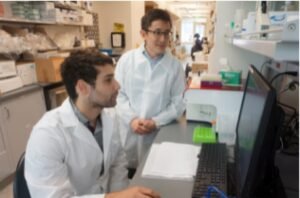Warmed gold nanoparticles release the remedial movement of designed CAR T cells.
Illusory antigen receptor (CAR) T cell treatment has had extraordinary accomplishment in treating blood malignancies. Be that as it may, with regards to strong growths, the treatment regularly comes up short. In strong cancers like sarcomas, the growth microenvironment smothers CAR T cells, making them less powerful.
Utilizing manufactured science, Gabriel Kwong, a biomedical specialist at Georgia Institute of Technology and Emory University, has fostered an innovation to control T cell treatments with warmth and make malignant growth cells more touchy to chemotherapy. The new innovation might reverse the situation for CAR T treatment accomplishment in strong growths.
“The possibility of spatially controlling the capacity of cell treatments is a truly significant and arising thought,” said Mikhail Shapiro, a compound architect at the California Institute of Technology, who was not associated with the examination. “This work is a vital stage in exhibiting that it works in vivo in a sensible malignant growth situation.”
Ali Zamat (left) and Gabe Kwong (right) consolidate heat treatment with CAR T cell treatment to contract growths in mice.
JERRY GRILLO, GEORGIA TECH
As an architect, Kwong has an exceptional way of thinking. Maybe than building a device and afterward attempting to track down the best application, Kwong attempts to distinguish the fundamental bottlenecks in a field first, then, at that point, he attempts to plan an answer. In the new exploration, he needed to control when and where CAR T cell treatment turns on and keep the cells off wherever else.
He and his group were propelled by the field of optogenetics, which uses light to control cell action. Light, notwithstanding, isn’t the best upgrade for disease medicines since it disperses in solid tissue and can just enter around 1 centimeter of tissue all things considered. Interestingly, warmth can be saved at extremely exact areas in the body.
Kwong and his group utilized gold nanoparticles that can take in the energy of close infrared light and convert it to warm in a spatially-controlled style. They designed quality switches in CAR T cells that would empower the cells to react to expansions in temperature of around three to five degrees Celsius, a knock a lot milder than drinking hot espresso or other warm fluids.
The analysts directed gold nanoparticles, which latently gather in growths, by means of IV infusion into mice with rear appendage cancers that had gotten the designed CAR T cells. Then, at that point, they illuminated the growths with close infrared light to raise the temperature.
Contrasted and mice that got just warmth therapy or CAR T cells, the growths in mice that got heat therapy and the designed CART cells contracted quicker, Kwong and his group revealed in Nature Biomedical Engineering.
“Where we can spatially control [CAR T cell] movement inside a cancer can very work on antitumor reactions,” Kwong said.
The treatment likewise forestalled backslide in the mice. Mice that got warmed phototherapy treatment remained growth free for over 45 days, while cancers returned in the accomplice treated with regular CAR T cells.
“It’s at the earliest reference point of this upheaval in medication, and there are many cool better approaches for tackling the issue,” Kwong said. “We need all the more huge cerebrums to chip away at this issue together.”
Reference
I. Mill operator et al., “Upgraded intratumoural action of CAR T cells designed to create immunomodulators under photothermal control,” Nat Biomed Eng, 1-12, 2021.


